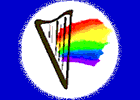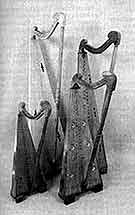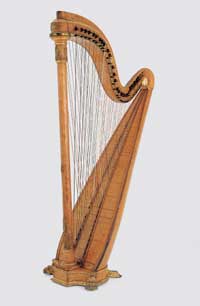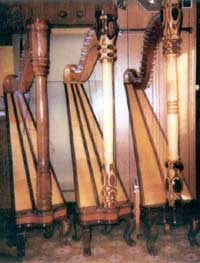














by Harper Tasche (Unabridged Version also available!)

|
| Harper Tasche with cross-strung harp. |
WHAT IS A CROSS-STRUNG HARP?
Imagine a portable harp that can play pop and jazz tunes, Renaissance church music, Ragtime, lush romantic music, beautiful classical pieces, and Celtic dance tunes and other ethnic music -- all without having to do anything extra like flip levers or move pedals. The cross-strung is it!
You could say that the cross-strung is "the harp that wouldn't die." Created in the late 1500s as a church instrument in Spain, it was virtually extinct by 1750 because of political and cultural upheaval. Completely re-invented as an orchestra instrument in the late 1800s in France, it met with harsh opposition from people who played other types of harps, and survived in only one Belgian conservatory. Now in the 21st century, after yet another re-invention in America's thriving folk harp movement, the cross-strung is gaining popularity as a fun (and easy to carry!) harp which brings all sorts of music within reach.
The contemporary cross-strung harp belongs to the "multi-course harp" family, meaning it has more than one set of strings (the terms "rows" or "courses" of strings are also used). This family includes the historical and contemporary double-strung harps, the historical and classical cross-strung harps, and the historical and traditional triple-strung harp.
The contemporary cross-strung harp has two sets of strings, one attached to each side of the neck of the harp, and the rows of strings intersect between the neck and the soundbox like an X. The set which runs from the lower left to the upper right (8:00 to 2:00 if you imagine a clock face) is tuned to a diatonic C major scale, like the white keys of a piano: C D E F G A B. The set which runs from upper left to lower right (10:00 to 4:00) is tuned pentatonically in F#/Gb, like the black keys of a piano: C# D# F# G# A#. This means that all the notes in the chromatic scale [like all the black and white piano notes] are available at all times, requiring nothing else but to play them: no levers to flip, and no pedals to move.

|
| The 'Rigel', a contemporary cross-strung harp by Blessley Instruments. (Photo by Douglas Brock) |
The two sets of strings cross near the midpoint of each string. The strings cross so that either hand can play either note. For example, middle C is played in the right hand above the point of crossing, and the very same string is played in the left hand below the point of crossing. If the right hand plays only above this point, it will be plucking strings that fit in the C major scale; if the right hand plays below this point, it will pluck strings from the F#/Gb pentatonic scale. As each hand moves up and down, above and below the point of crossing, the hand moves from one set of strings to the other.
WHERE DID THIS TYPE OF HARP COME FROM?
The earliest record of a harp made with crossing strings is from Madrid, Spain, in the late 1500s (see article by
Hannelore Devære). This instrument, called the arpa de dos òrdenes, was created for church use. It was fitted with lightweight gut strings, and produced a rather soft and fairly "bright" sound much like that of other Renaissance and late Medieval harps.
(see article by Cheryl Ann Fulton).

|
| Reproduction Renaissance Spanish cross-strung harps built by Pedro Llopis Areny. |
The arpa de dos òrdenes was very popular in Spain, but by the end of the 1700s the royal court was primarily interested in French and Italian culture. Subsequently, Spanish music and musical instruments (including the cross-strung harp) fell from favor and were gradually replaced by French and Italian instruments (such as the violin and the harpsichord).
The cross-strung harp was totally reinvented in the late 1800s, this time in Paris by a musical instrument builder named Gustav Lyon who worked for a piano company called Pleyel & Wolff. Frustrated with the double-action pedal harp's limitations in highly chromatic music, several harpists urged him to make a harp that could modulate easily between key signatures. What became known as the Pleyel cross-strung harp was an entirely different instrument from its Renaissance Spanish ancestor, retaining only the two rows of crossing strings tuned to diatonic and pentatonic scales.

|
| An early 20th century orchestral cross-strung harp by Pleyel & Wolff, Paris (From the 'Three Centuries of Harpmaking' collection, Victor Salvi Foundation) |
The Pleyel harp was built like a pedal harp: fitted with heavy gut strings for most of its range, it produced a big and fairly "dark" sound very well suited for Romantic-era symphony orchestras and as a solo instrument in large concert halls. The Pleyel cross-strung was manufactured until 1930, but the factory did not survive World War II.
Instruction was provided on the Pleyel cross-strung at the conservatory in Paris for only a few years in the early 1900s, but it has been taught in small but dedicated classes at the conservatory in Brussels for most of the 20th century. (The current "grande dame" of classical cross-strung harp is Francette Bartholomée, who has released two marvelous recordings which can be found at www.arkivmusic.com.) After the demise of the Pleyel factory, a Welsh luthier named John Thomas made several smaller cross-strung harps based on the Pleyel model for conservatory use.
The contemporary cross-strung harp was born from a series of chance encounters half a world away, fueled by the curiosity and determination of a very few individuals. A cross-strung harp believed to have been built by John Thomas appeared for repair at the workshop of California luthier Roland (Robbie) Robinson in the early 1980s. Robinson was intrigued; he drew sketches of the harp and wrote a description of it, which he published in a fledgling magazine he had founded called the Folk Harp Journal.
A retired machinist in British Columbia, Emil Geering, had begun building harps as a hobby. He saw Robinson's published article and sketches, and decided to try his hand; he subsequently made a lot of them! (Emil Geering died in 1997.)

|
| Two late 20th century cross-strung harps (left and center) by Emil Geering, BC Canada (Photo by Francine Aylward) |
Ben Brown, an emerging instrumentalist in Michigan, also "discovered" the cross-strung harp and became its strongest advocate in North America during the late 1980s and early 1990s. He obtained one of Geering's harps, taught himself to play it, and convinced two American luthiers to make cross-strung harps as well, Dan Speer, of Argent Fox Music in Bloomington, Indiana, and Pat O'Loughlin, in St. Paul, Minnesota.
Harper Tasche (your author), a classically trained multi-instrumentalist and composer in Washington State, learned of the cross-strung harp in the mid-1990s. I was thrilled with the instrument's chromatic potential after having played a purely diatonic folk harp for several years, so I ordered one "sight unseen" from Argent Fox Music, taught myself to play it, and made my debut with it at the International Folk Harp Conference in 1996. As Ben Brown's attention turned to other pursuits, I found myself at the forefront of a resurgence of interest in cross-strung harps which continues to grow and shows no signs of stopping.
Now, in the first years of the 21st century, numerous harp builders internationally are producing high-quality cross-strung harps in a wide variety of sizes and styles. For some examples, Argent Fox Music now makes three models, and Pat O'Loughlin makes three models; Blessley Instruments (Vancouver, Washington) makes two models; and Blevins Harps (Grand Junction, Colorado) makes three models. Stoney End Harps (Red Wing, Minnesota), Mountain Glen Harps (Phoenix, Oregon), and William Rees Harps (Rising Sun, Indiana) make one model of cross-strung harp each. Harps & Harps (New South Wales, Australia) makes several models; and Philippe SRL Clément (Ontario, Canada) made several models of cross-strung harps, but has since retired.
Notably, these cross-strung harps are all designed and built on folk harp models rather than either the historical Spanish or classical French cross-strung harps. Like the Pleyel, however, they are still fully chromatic, with both sets of strings equally accessible to both hands.

|
| Inaugural Cross-Strung Harp Camp, 1999. From left: Bill McJohn with arpa de dos òrdenes reproduction by David Kortier, Lethea Erz with cross-strung by Glen Hill, Bonnie Pulliam with "Lord David" model by Argent Fox Instruments, Peter Borgwardt with two "Brother Benjamine" models by Argent Fox, "Esabelle" lap cross-strung by Stoney End (center; attendee Diane Moss not shown), Francine Aylward with Geering cross-strung, and Harper Tasche with "Rigel" and "Orion" models by Blessley Instruments. (Photo by Diane Moss) |
Increasing numbers of musicians are also including the contemporary cross-strung harp among their instruments of choice. A few notable professional artists include Verlene Schermer (San Jose, California), Cynthia Lynn Douglass (Birmingham, Alabama), and Liz Cifani (Chicago, Illinois). Because the cross-strung harp's revival is occurring in the context of the remarkable North American folk harp movement, contemporary players are bringing an energetic and delightfully experimental perspective to the instrument. An eclectic repertoire is emerging for the cross-strung which encompasses numerous ethnic traditional styles (Celtic, Nordic, African, etc) and pop & jazz, as well as a great deal of classical and historical music which is often difficult or simply unplayable by lever or pedal harp.
HOW IS THE CROSS-STRUNG HARP PLAYED?
There are several differences between playing this harp and playing other types of harps. For one brief example, the same music is often fingered very differently on a cross-strung harp than on a single-course harp. Let's use a D major triad for an example, which contains the notes D F# A. To play this chord on a lever or pedal harp, one would simply change the pitch of the F strings into F sharps by mechanical means. The fingers used to play these notes, typically 3 2 1, are the same in each hand.

|
| D Major triad on lever harp, left hand (Photo by Douglas Brock) |

|
| The same chord on cross-strung harp (Photo by Douglas Brock) |
On the cross-strung, however, the D and the A will be on the diatonic row (up in the right hand, down in the left), and the F# will be on the chromatic row (down in the right hand, up in the left). Therefore, the left hand fingering is 4 2 1 (fourth finger because it makes the reach upward to F# easier for the index finger).
The right hand plays 2 4 1 for the same notes (with fourth finger reaching down for F#; again, fourth finger is used for an easier reach).
The contemporary North American cross-strung harp has a great deal of "catching up" to do, given its re-emergence over only the past twenty years and the vast differences in playing technique between it and single-course harps. I am confident, however, that as more and more people study, play, write, perform, and teach with this instrument, successive generations of players will almost certainly surpass current abilities. It is a very exciting time for the cross-strung harp!
FOR FURTHER INFORMATION, the following are a good start:
Harper Tasche may be seen playing the cross-strung harp on several YouTube videos, including http://www.youtube.com/watch?v=s0uNzLV22Ks.
"How To Play The Cross-Strung Harp" by Harper Tasche (2001). This thorough tutorial includes an illustrated overview of techniques, and scales, chords, and exercises in twenty-four keys, plus fully fingered musical selections in each of twelve key signatures. It also contains suggestions for repertoire, and contact information for some contemporary cross-strung builders, performers, and teachers. (A Japanese translation is also now in print.) Available from Harper Tasche, www.harpcrossing.com.
"X-Harps: History, Playing Technique, Music and Construction of the Cross Strung Chromatic Harp" by Philippe SRL Clément, luthier, with Belgian musicologist/harpist Hannelore Devaere (1998). This is an invaluable compendium of information previously untranslated from French and Dutch, as well as new material in English by William Taylor, Harper Tasche, and Verlene Schermer. Included are musical examples and exercises from the tutorial by Odile Tackoen and others, contact information for some cross-strung harp builders, teachers, and performers, and a list of about 135 classical works written specifically for the Pleyel harp. This work may be out of print; inquire of Philippe Clément, RR#3 Napanee, Ontario, Canada K7R 3K8. The informational portions of Philippe Clement's former website have been integrated into the site run by Roger Muma at www.mumaharps.com/harps/xharp/.
Christoph Pampuch's German company, harpa mundi, is making a new kind of cross-strung chromatic harp. See it at https://christophpampuch.ch/noten_keltischeharfe.htm in German, English and French.
At www.harponomie.be/histoire-harpe-chromatique.htm there is a short history (in French) of the chromatic harp in Belgium, and a link to its modern revival.
Historical Harp | Folk and World Harp | Pedal Harp |
Harp Building | Harp Works | Non-Harps |
Camps & Concerts | Links | Glossary |
Donate! | Get Involved! | Contact Us | About Harp Spectrum
Copyright 2002 - 2017, Harp Spectrum All Rights Reserved